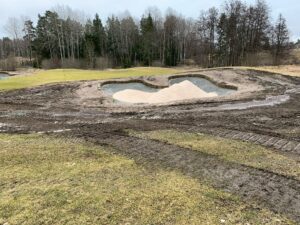Viksjö Golf Course revamps its bunkers
Related Articles
Opened in 1970, the Viksjö course in Stockholm is an important venue in the history of Swedish golf. “Viksjö held some of the first professional golfing events in Sweden in the 1970s,” says Martin Sternberg, founder and CEO of CapillaryFlow. “As well as its role in the establishment of golf in Sweden, it is an important venue for my family. My father was one of the top amateurs in the country at the time. He played in some of these events, and they motivated him into turning professional later, when he was 45 years old. They were also the precursor for the Scandinavian Enterprise Open, which turned into the Scandinavian Masters and is still the biggest professional golf event in the country every year.”
Viksjö rebuilt its greens and bunkers between 2006 and 2008. “The bunkers were rebuilt in the same style as they were originally, with no liner, just drainage,” says course manager Urban Nilsson. “They were very deep and quite large – they were a real challenge to maintain.”
Several years ago, Viksjö engaged architect Johan Benestam to create a course masterplan, incorporating new bunkers and some new tees. “Before this work, the bunkers were grass faced, with a low sand line, and they were hard to see,” says Benestam. “I believe that visibility of hazards – being able to see at least 20-30cm of sand – is very important. When you can see the hazards, they have more of an influence on the game – they get in your mind.”
“I knew that I wanted us to use a liner, but I wasn’t sure which one,” says Nilsson. “But seven or eight years ago, we did a test bunker with Capillary, and we never have any problems with that one.” Architect Benestam, and the chosen contractor, Nelson & Vecchio, also have a lot of experience with CapillaryFlow, and this, combined with excellent feedback which Nilsson got from a number of local course managers, sealed the deal.
The project involves the construction of 45 new bunkers, including two on the practice ground – the total area of sand on the course will be reduced from 5,500 sq m to 2,600 sq m. Work started at the end of February, and will wrap up in the middle of May. “I was worried that it would be too early, but we haven’t had so much frost this winter – the ground froze to a depth of only 10cm,” says Nilsson. Contractor David Nelson says: “This winter has been very mild for that part of Scandinavia, although the day we mobilised on site was the day that 60cm of snow fell and stayed there for two weeks. If the ground is frozen we can’t work but the snow insulated the ground so we were able to move it and continue working.”
“The members are going to see big changes from the renovation. Prior to the work, a lot of the bunkers were not visible because of the low sand, now they will have a good view of what is in front of them,” says Nelson. “One advantage of this project is that, because of the reduced amount of bunker maintenance we will need, we will be able to hand rake,” says Nilsson. “I’m pretty sure that, because of the reduced time it will take to maintain the bunkers, over a ten to fifteen year period we will save a substantial amount of money with CapillaryFlow.”


























